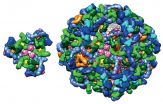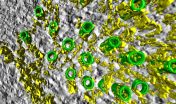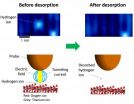Cell machinery wears complex coat
2015-07-10
(Press-News.org) Heidelberg, 10 July 2015 - Researchers at EMBL Heidelberg have produced detailed images of the intricate protein-coats that surround trafficking vesicles - the "transport pods" that move material around within biological cells. The study, published today in Science, provides a new understanding of the complex machines that make up the cells' logistics network.
Vesicles are responsible for transporting molecules between the different compartments within a cell and also for bringing material into cells from outside. There are several types of vesicle: each has a specific type of coat which is made up of different proteins and assembles onto a membrane surrounding the vesicle.
The EMBL team has been taking a close look at a coat called COPI. This surrounds vesicles that move material around within the Golgi apparatus and to the endoplasmic reticulum (ER) - these are regions of the cell where proteins are made and modified in preparation for transport to the cell surface.
Using a technique called cryo-electron tomography, in which samples can be frozen at very low temperatures to avoid fixing or staining them chemically, the researchers combined data from hundreds of vesicles to build up a 3D image of the COPI coat. This enabled them to produce the most detailed pictures yet obtained of a vesicle coat assembled on the vesicle membrane.
This imaging technique is still in its infancy and although scientists have been able to gather structural information about parts of the membrane coats in other types of vesicle, this is the first time a model of a complete assembled vesicle coat has been produced.
What the images revealed was surprising: unlike other types of vesicle, where the coat is thought to be made from proteins assembled in different layers - each with a specific function - around the vesicle membrane, the EMBL team observed that the proteins in the COPI coat all intertwine together in one big layer, which is curved to fit around the membrane. More precisely, the COPI coat is made of a repetition of building blocks, called "triads", that contain all the important functional elements organised in a precise 3D structure.
"Until now we could see different elements of the vesicle coat, but not get a complete and detailed picture of the coat assembled onto the vesicle membrane. This is an important step forward for our understanding of intracellular transportation," explains John Briggs who led the study.
"Our images showed us how the proteins that make up the coat are arranged and it was surprising to discover how different COPI is from, for example, clathrin or COPII coated vesicles," adds Svetlana Dodonova, co-author of the paper. "Our next step will be to try to find out how this coat forms and binds to the vesicle membrane and how it arranges itself into such complex shapes."
INFORMATION:
The research was funded by the German Research Foundation, and carried out in collaboration with Felix Wieland at the University of Heidelberg.
[Attachments] See images for this press release:

ELSE PRESS RELEASES FROM THIS DATE:
2015-07-10
University of Warwick researchers have discovered a cell structure which could help scientists understand why some cancers develop.
For the first time a structure called 'the mesh' has been identified which helps to hold together cells. This discovery, which has been published in the online journal eLife, changes our understanding of the cell's internal scaffolding.
This also has implications for researchers' understanding of cancer cells as the mesh is partly made of a protein which is found to change in certain cancers, such as those of the breast and bladder.
The ...
2015-07-10
Treating obese pregnant women with a diabetes drug does not stop their babies from being born overweight, a study has found.
Doctors had hoped that the treatment would help to reduce obesity rates and lower the number of difficult births.
Heavier babies are more likely to grow into overweight adults. They also have a higher risk of illnesses later in life, such as diabetes and heart disease.
It is thought that the additional weight gain in the womb is caused by exposure to excess blood sugar.
Researchers tested whether treating overweight mothers-to-be with the ...
2015-07-10
A research team comprising scientists from Tohoku University, RIKEN, the University of Tokyo, Chiba University and University College London have discovered a new chemical reaction pathway on titanium dioxide (TiO2), an important photocatalytic material.
The reaction mechanism, reported in ACS Nano, involves the application of an electric field that narrows the width of the reaction barrier, thereby allowing hydrogen atoms to tunnel away from the surface. This opens the way for the manipulation of the atomic-scale transport channels of hydrogen, which could be important ...
2015-07-10
(BOSTON) - Traditional robots are made of components and rigid materials like you might see on an automotive assembly line - metal and hydraulic parts, harshly rigid, and extremely strong. But away from the assembly line, for robots to harmoniously assist humans in close-range tasks scientists are designing new classes of soft-bodied robots. Yet one of the challenges is integrating soft materials with requisite rigid components that power and control the robot's body. At the interface of these materials, stresses concentrate and structural integrity can be compromised, ...
2015-07-10
The middle classes from developing countries are more susceptible than western Caucasians to obesity, type 2 diabetes and cardiovascular disease in today's changing environment. New research published today in Cell Metabolism from the University of Sydney in Australia, the National Centre for Cell Science and the DYP Medical College in Pune, India reveals this may be a result of the nutrition endured by their ancestors.
The findings in the paper titled Multigenerational Undernutrition and Diabetes could explain projections that more than 70 per cent of the global burden ...
2015-07-10
ORLANDO, FL - While multidirectional instability of the shoulder (MDI) has been traditionally treated without surgery, research presented today at the American Orthopaedic Society for Sports Medicine's (AOSSM) Annual Meeting in Orlando, FL, shows surgery is also effective for this type of dislocation.
"We examined 41 athletes who received arthroscopic surgery for MDI, and noted 73% returned to play at equal or only slightly lower level than before the injury," commented M. Brett Raynor, MD, lead author from Steadman Philippon Research Institute Program. "Our study group ...
2015-07-10
ORLANDO, FL - Athletes who suffer a shoulder instability injury may return to play more successfully after being treated arthroscopically compared to nonoperative treatment, say researchers presenting their work today at the American Orthopaedic Society for Sports Medicine's (AOSSM) Annual Meeting.
"Our research highlights that collegiate collision athletes with in-season shoulder instability injuries are more likely to return to sport successfully the following season, if they undergo arthroscopic stabilization compared to nonoperative treatment," said lead author Jon ...
2015-07-10
ORLANDO, FL - While athletes undergoing anterior cruciate ligament (ACL) surgery often have an additional meniscus injury, treating these tears at the same time may not be necessary. Research presented today by the MOON Knee Group at the American Orthopaedic Society for Sports Medicine's (AOSSM) Annual Meeting in Orlando shows positive results for meniscal tears that were deemed stable and left alone at the time of ACL reconstruction.
"We examined 194 patients with meniscus tears who did not receive treatment at the time of ACL surgery," noted lead author Kyle R. Duchman, ...
2015-07-10
Chronic obstructive pulmonary disease (COPD) is one of most common causes of death in the world today - active smoking accounting for approx. 85% of all cases. Yet ground-breaking research from the University of Copenhagen indicates that accelerated decline of lung function is not a prerequisite for COPD.
It has been generally assumed that all people suffering COPD experience an accelerated decline of lung function, which is why so many large studies have focused on reducing this decline. However, this new study reveals that this is the case for only approx. 50% of patients ...
2015-07-10
CANCER RESEARCH UK scientists have found that 'jumping genes' may add to the genetic chaos behind more than three-quarters of oesophageal cancer cases, according to research* published in BMC Genomics today (Friday).
The scientists, from the University of Cambridge, used cutting-edge technology that can read DNA to study the genes of 43 oesophageal tumour and blood samples to discover how much these mobile genetic sequences travel.
'Jumping genes', called L1 elements, can uproot themselves and move to new areas in the DNA, sometimes accidentally moving into genes that ...
LAST 30 PRESS RELEASES:
[Press-News.org] Cell machinery wears complex coat


